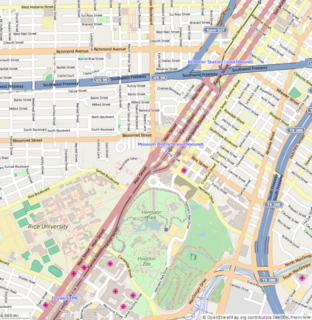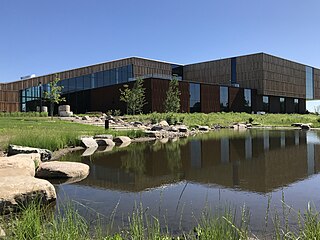Related Research Articles

The Lawrence Hall of Science is a public science center in Berkeley, California that offers hands-on science exhibits, designs curriculum, aids professional development, and offers after school science resources to students of all ages. The Hall was established in 1968 in honor of physicist Ernest Orlando Lawrence (1901–1958), the University of California's first Nobel laureate. The Hall is located in the hills above the University of California, Berkeley campus, less than a mile uphill from the University's Botanical Garden.

Griffith Observatory is a facility in Los Angeles, California, sitting on the south-facing slope of Mount Hollywood in Los Angeles' Griffith Park. It commands a view of the Los Angeles Basin, including Downtown Los Angeles to the southeast, Hollywood to the south, and the Pacific Ocean to the southwest. The observatory is a popular tourist attraction with a close view of the Hollywood Sign and an extensive array of space and science-related displays. Admission has been free since the observatory's opening in 1935, in accordance with the will of Griffith J. Griffith, the benefactor after whom the observatory is named.

Liberty Science Center is an interactive science museum and learning center located in Liberty State Park in Jersey City in Hudson County, New Jersey, United States.

The Fernbank Science Center is a museum, classroom, and woodland complex located in Atlanta. It is owned and operated by the DeKalb County School System, which announced in May 2012 it was considering closing the facility to cut its annual budget, then quickly shelved the plan after public outcry. The nearby Fernbank Museum of Natural History is a private non-profit organization that is separate from the Science Center.

The Carnegie Science Center is one of the four Carnegie Museums of Pittsburgh, Pennsylvania. It is located in the Chateau neighborhood. It is located across the street from Heinz Field.

Naypyidaw, officially spelled Nay Pyi Taw, is the capital and third-largest city of Myanmar. The city is located at the center of the Naypyidaw Union Territory. It is unusual among Myanmar's cities, as it is an entirely planned city outside of any state or region. The city, then known only as Pyinmana District, officially replaced Yangon as the administrative capital of Myanmar on 6 November 2005; its official name was revealed to the public on Armed Forces Day, 27 March 2006.

The Fleet Science Center is a science museum and planetarium in Balboa Park, located in San Diego, California. It is at the east end of the El Prado Drive walkway, next to the Bea Evenson Fountain and plaza in central Balboa Park.

The McLaughlin Planetarium is a former working planetarium whose building occupies a space immediately to the south of the Royal Ontario Museum in Toronto, at 100 Queen's Park. Founded by a grant from philanthropist Colonel R. Samuel McLaughlin, the facility was opened to the public on October 26, 1968. It had, for its time, a state-of-the-art electro-mechanical Zeiss planetarium projector that was used to project regular themed shows about the stars, planets, and cosmology for visitors. By the 1980s the planetarium's sound-system and domed ceiling were used to display dazzling music-themed laser-light shows. The lower levels of the planetarium contained a gallery called the "Astrocentre" that featured space-related exhibits, related artifacts on the history of astronomy and was also home of the world's first commercial Stellarium

The Houston Museum of Natural Science is a natural history museum located on the northern border of Hermann Park in Houston, Texas, United States. The museum was established in 1909 by the Houston Museum and Scientific Society, an organization whose goals were to provide a free institution for the people of Houston focusing on education and science. Museum attendance totals over two million visitors each year. The museum complex consists of a central facility with four floors of natural science halls and exhibits, the Burke Baker Planetarium, the Cockrell Butterfly Center, and the Wortham Giant Screen Theatre. The museum is one of the most popular in the United States and ranks just below New York City's American Museum of Natural History and Metropolitan Museum of Art and the M. H. de Young Memorial Museum in San Francisco in most attendance amongst non-Smithsonian museums. Much of the museum's popularity is attributed to its large number of special or guest exhibits.

The Rose Center for Earth and Space is a part of the American Museum of Natural History in New York City. The Center's complete name is The Frederick Phineas and Sandra Priest Rose Center for Earth and Space. The main entrance is located on the northern side of the museum on 81st Street near Central Park West in Manhattan's Upper West Side. Completed in 2000, it includes the new Hayden Planetarium, the original of which was opened in 1935 and closed in 1997. Neil deGrasse Tyson is its first and, to date, only director.

The Bell Museum, formerly known as the James Ford Bell Museum of Natural History, is located at the University of Minnesota. The museum's new location on the St. Paul campus opened July 13–15, 2018. The world-renowned Minnesota wildlife dioramas, numerous animal specimens from all over the world, and the 120-seat digital Whitney and Elizabeth MacMillan Planetarium theater are highlighted features of the new facility. The museum's former location in Minneapolis is closed as the work to move to the University of Minnesota's St. Paul campus began in January 2017. The museum is part of the University's College of Food, Agricultural and Natural Resource Sciences.

The Tulsa Air and Space Museum (TASM) is an aerospace museum in Tulsa, Oklahoma, United States. It is located in the northwest corner of the Tulsa International Airport property. It has 19,000 square feet (1,800 m2) of historical exhibits, hands-on activities, and vintage aircraft. A full-dome planetarium was added in 2006. The museum also has educational facilities for school visits, summer camps, and Scout groups.

The South Florida Science Center and Aquarium (SFSCA) is located at 4801 Dreher Trail North, West Palm Beach, Florida, USA. Founded in 1959, the goal of the organization is to open every mind to science through the strategic programming of interactive exhibits and engaging community-based camps and events. The SFSCA has expanded since its creation and now houses over 50 hands-on exhibits, a planetarium, a 3000 square foot aquarium, a miniature golf course, and a large exhibit space that displays a temporary travelling exhibit. The SFSCA is a member of the ASTC program, which offers a membership that is redeemable at other ASTC science and technology centers around the world. The SFSCA occupies Dreher Park alongside the Palm Beach Zoo and offers deals for entrance to both facilities. The phone number for the South Florida Science Center and Aquarium is (561) 832-1988.

The Museum of Science & History (MOSH) is a museum in Jacksonville, Florida. It is a private, non-profit institution located on the Southbank Riverwalk, and the city's most visited museum. It specializes in science and local history exhibits. It features a large traveling exhibit that changes quarterly, three floors of permanent and signature exhibits, and the Bryan-Gooding Planetarium.

The Fairbanks Museum & Planetarium is a combination natural science museum, history museum, and planetarium located in St. Johnsbury, Vermont. It was founded in 1890 by businessman, politician, naturalist, and collector Franklin Fairbanks. The museum and its buildings are on the U.S. National Register of Historic Places.
The Science Center for Education is a science museum in Khlong Toei District, Bangkok, Thailand. It is located next to the Eastern Bus Terminal (Ekkamai) on Sukhumvit Road, and is a science exhibition center. It includes an aquarium, a computer world, a planetarium, and workshops/devices intended for children.

The Astronaut Memorial Planetarium and Observatory, or AMPO, also known as the Eastern Florida State College Planetarium and Observatory, is an astronomical observatory and planetarium at Eastern Florida State College in Cocoa, Florida. The facility consists of a planetarium, public observatory, large-screen movie theater, exhibit halls, multi-media classroom and an art gallery.

B. M. Birla Planetarium is a large planetarium in Chennai providing a virtual tour of the night sky and holding cosmic shows on a specially perforated hemispherical aluminium inner dome. The fifth B. M. Birla planetarium in the country, it is located at Kotturpuram in the Periyar Science and Technology Centre campus which houses eight galleries, namely, Physical Science, Electronics and Communication, Energy, Life Science, Innovation, Transport, International Dolls and Children and Materials Science, with over 500 exhibits. Built in 1988 in the memory of the great industrialist and visionary of India B. M. Birla, it is the most modern planetarium in India. Other Birla planetariums in India include the M. P. Birla Planetarium in Kolkata, the Birla Planetarium in Hyderabad, and the planetariums in Tiruchirapalli and Coimbatore.

The Rio Tinto Alcan Planetarium is the successor to the Montreal Planetarium, and is located in the Espace pour la Vie, near the Olympic Stadium and the Biodome in Montreal, Quebec, Canada. The new installation has two separate theatres as well as exhibits on space and astronomy. It was officially opened in April 2013.

The Melaka Planetarium is a planetarium in Ayer Keroh, Central Melaka District, Melaka, Malaysia.